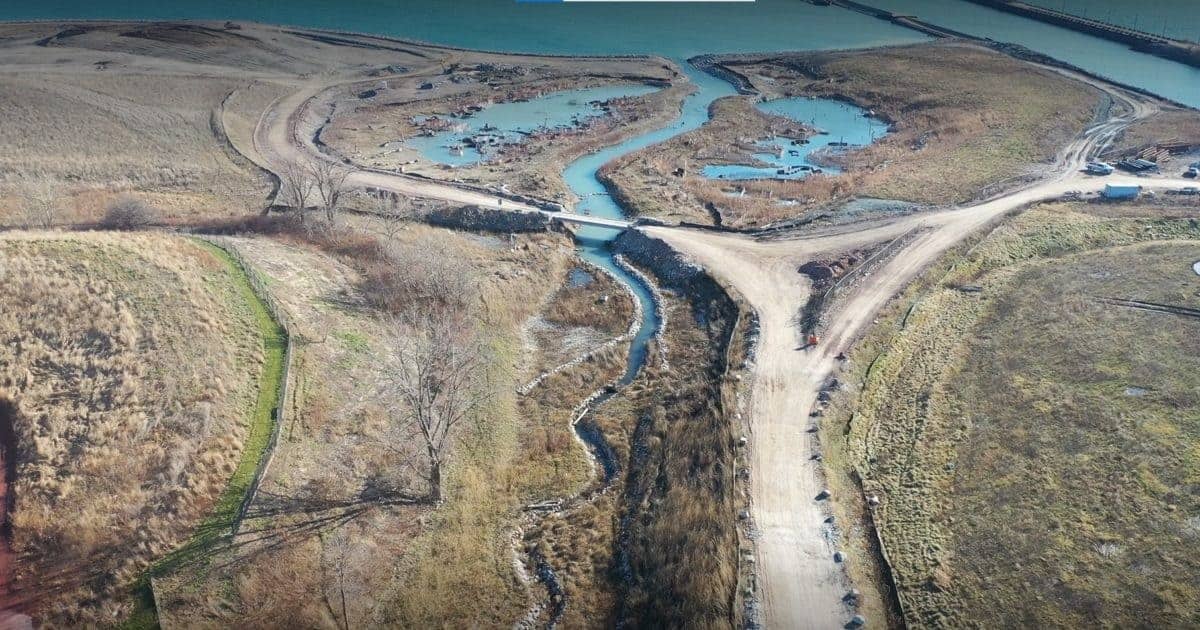Mississauga’s ‘lost river’ once again flows into Lake Ontario
Published July 29, 2022 at 2:25 pm

For the first time in nearly 60 years, fish can once again swim freely between a “lost river” in Mississauga and Lake Ontario.
As part of the development of the huge Lakeview Village community along the eastern waterfront in Mississauga, Serson Creek, a nearby tributary and natural habitat that has suffered from decades of industrial use, has been “daylighted” by the local conservation authority and developer.
The move will lead to sweeping benefits that go well beyond the fish population, officials say.
The creek was disconnected from the lake in the mid-1960s, when it was buried and piped underground, essentially becoming one of Mississauga’s “lost rivers,” say officials at University of Toronto Mississauga’s (UTM) Blackwood Gallery.
Lost rivers are waterways that have been buried beneath ground to make way for development.
The gallery is hosting a public walking tour/conversation between developer Lakeview Community Partners Limited (LCPL) and Credit Valley Conservation (CVC) on Aug. 11 from 5 to 7 p.m.
Those interested in attending are asked to register in advance. The walking tour will go ahead as scheduled, rain or shine.
“Together with the Lakeview Community Partners, the CVC carefully planned and designed the process to restore Serson Creek to its former glory,” Blackwood Gallery said. “This has been a rare opportunity and may be the first lost river to be reconnected to Lake Ontario.”
CVC officials say the creek was reconnected to Lake Ontario last December via a newly-constructed path between the smaller watercourse and the lake.
“What was once a forgotten creek is now the realization of a dream,” CVC officials said in an online description of the huge project.
The restoration of Serson Creek began in 2016, when the CVC, Region of Peel and Toronto and Region Conservation Authority began work on a new conservation area along Mississauga’s waterfront.
“From the start, one of our goals was bringing Serson Creek back to life,” the CVC said.
Lakeview Village development lead Brian Sutherland said earlier that the creek restoration is just the first “in a number of meaningful ways” that the new 177-acre community will transform Mississauga’s waterfront.
“We’re so proud to have seen our collective efforts culminate with the reconnection of the creek to the lake late last year,” Sutherland said. “It’s been a privilege working with the CVC, the Region of Peel and the City to bring this beautiful creek back to life. It’s the first step of many we’re taking to restore the area’s natural habitat that has suffered through years of industrial use.”
CVC officials say that, moving forward, fish can now live in the creek and swim up and down its length. This past spring, the conservation authority began monitoring the watercourse to see if fish are travelling upstream.
“Fish aren’t the only wildlife that will benefit from this transformation. The new Serson Creek valley has been planted with trees and shrubs that will provide new homes to many species including birds, mammals and amphibians,” the CVC says. “The creek will also help build resiliency to local flooding. The creek is now connected to the newly created Serson Creek wetland that will soak up extra water during heavy storms.”
The restored Serson Creek flows into the Jim Tovey Lakeview Conservation Area, which will offer 26 hectares of additional greenspace when it opens in 2025.
Lakeview Village is a mixed-use waterfront development of 8,050 new homes that’s also expected to bring some 9,000 long-term jobs to Mississauga when it’s completed.
The huge site was once home to the Lakeview Generating Station, which was shut down in 2005 complete with the controlled demolition of the iconic smokestacks known for decades as “The Four Sisters.”
INsauga's Editorial Standards and Policies